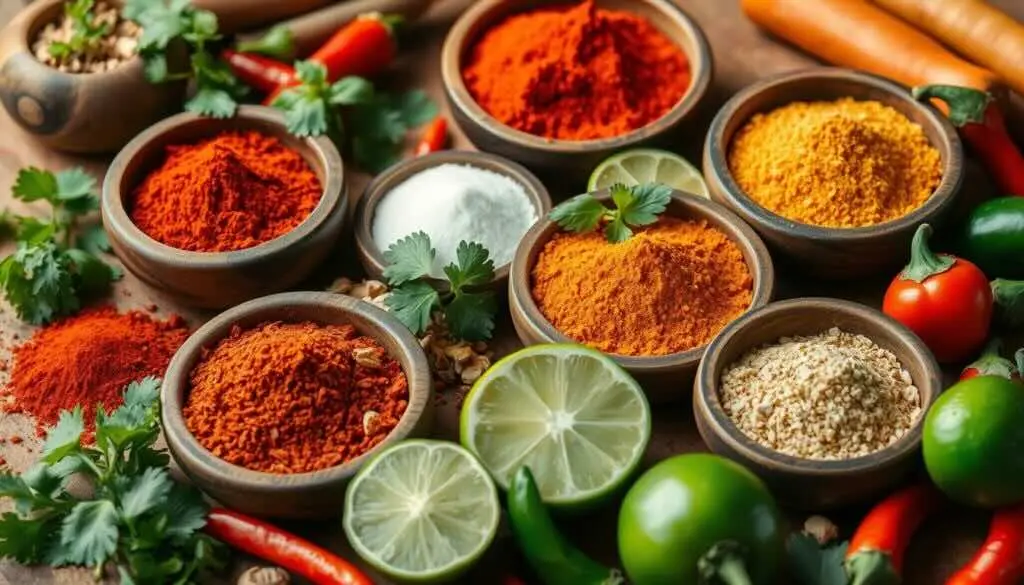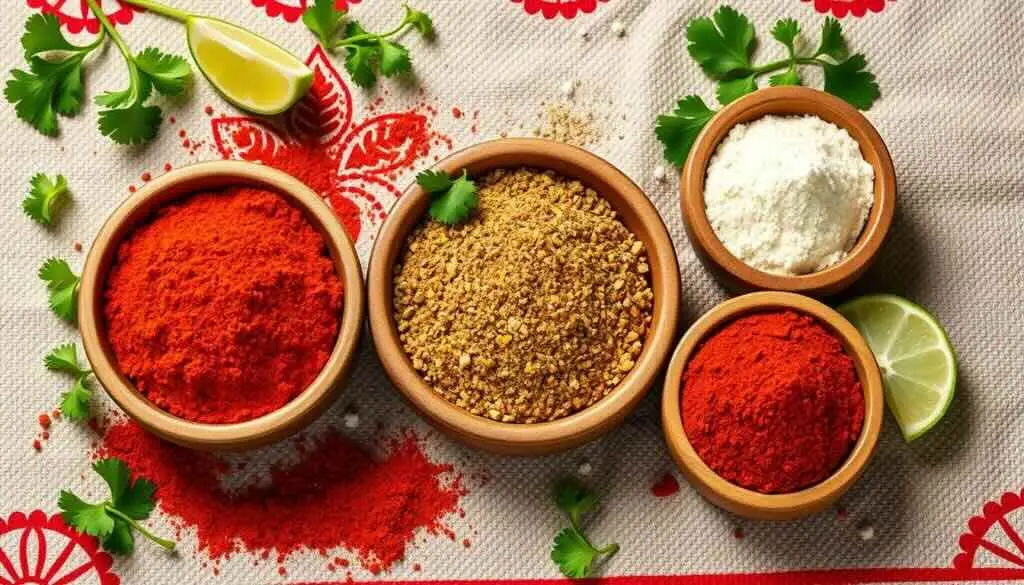- Are you tired of meals that are just plain boring? Want to add some excitement to your cooking? A simple sprinkle of tex mex seasoning can change everything.
Tex mex seasoning is a mix of Mexican, Southern, and cowboy cooking styles. It turns simple dishes into amazing meals. The spices in this blend create a unique taste experience.
Imagine making meals as good as those in a restaurant, all from your kitchen. Tex mex seasoning adds depth and authentic flavor to any dish. It’s perfect for tacos or grilled meats.
Table of Contents
Key Takeaways
- Tex mex seasoning combines multiple cultural cooking influences
- Contains key spices like cumin, chili powder, and Mexican oregano
- Versatile enough to enhance meats, vegetables, soups, and stews
- Offers customizable heat levels for different palates
- Easy to use and transformative for home cooking
Understanding the Essence of Tex Mex Seasoning
Tex Mex seasoning is a mix of Texas and Mexico’s bold flavors. It turns simple dishes into amazing meals. This blend is at the heart of southwestern cooking.

Origins and Cultural Significance
The history of tex-mex seasoning is rooted in the American Southwest. It was created by home cooks and chefs over time. This seasoning blend is a story of cultural mix and creativity in food.
- Emerged from border region cooking traditions
- Blends Native American, Mexican, and Texan culinary influences
- Represents a dynamic food culture that continues to evolve
Traditional vs Modern Blends
Old-school tex mex seasoning was simple. Today’s versions are more complex, mixing global tastes with true roots.
A survey found 75% of people love Tex-Mex for its freshness. This has led to new seasoning mixes. Now, these mixes have 20% to 60% spices, offering deeper flavors.
Key Flavor Profiles
Tex Mex seasoning is known for its unique taste. It usually has:
- Smokiness from smoked paprika (10-15% of mix)
- Warm earthiness from cumin
- Subtle heat from chili powders
- Depth from garlic and onion
With sales up 15% in the last year, tex mex seasoning is still a hit. It’s loved by both home cooks and chefs, showing its lasting appeal in American food.
Essential Spices in Authentic Tex Mex Seasoning

Making the perfect tex mex seasoning is an art. It combines special spices for a burst of flavor. Each spice adds to the complex taste that makes Tex Mex cuisine unique.
Let’s look at the key spices that make tex mex seasoning stand out:
- Chili Powder: The heart of any tex mex seasoning, used in 90% of chili con carne recipes. It adds heat and color to your dishes.
- Cumin: A key spice in Tex Mex, found in 100% of traditional recipes. It brings a warm, earthy flavor to the blend.
- Paprika: Used in 75% of Texas-style recipes, it adds sweetness and a rich red color.
- Garlic Powder: A versatile spice with a long shelf life, making it a must-have in blends.
- Dried Oregano: Adds herbal notes that enhance the flavor.
Using high-quality, fresh spices makes your tex mex seasoning blend truly special. Each spice is vital in creating that unique taste. It turns simple meals into unforgettable dishes.
Pro tip: Play with the spice amounts to find your ideal mix. Some add cayenne for more heat or ground chipotle for smokiness.
How to Make Your Own Tex Mex Seasoning
Making your own tex mex seasoning is simple. Just a few ingredients and a short time can make your meals taste amazing.
By making your own seasoning, you can adjust the flavor and skip the additives in store-bought mixes. It only takes 5 minutes, making it a fun kitchen task.
Base Ingredients for Tex Mex Seasoning
- Chili powder (1 tablespoon)
- Ground cumin (1½ teaspoons)
- Paprika (½ teaspoon)
- Garlic powder (¼ teaspoon)
- Onion powder (¼ teaspoon)
- Dried oregano (¼ teaspoon)
- Sea salt (1 teaspoon)
- Black pepper (1 teaspoon)
- Crushed red pepper flakes (¼ teaspoon)
Mixing Ratios and Proportions
For great tex mex seasoning, get the mix right. Use 2-3 tablespoons for every pound of meat. For veggies or as a rub, adjust to taste.
| Dish Type | Seasoning Amount |
|---|---|
| Ground Meat | 3 tablespoons per pound |
| Roasted Vegetables | 1-2 tablespoons |
| Grilling Rub | 2 tablespoons |
Storage Tips and Shelf Life
Keep your seasoning in an airtight container in a cool, dark spot. It stays fresh for up to 6 months. Remember to label it with the date you made it.
By making your own seasoning, you save money and control the sodium. Plus, you get a fresher taste in your dishes.
Popular Dishes Enhanced with Tex Mex Seasoning
Tex mex seasoning makes simple meals into amazing dishes. It’s a versatile spice that can make any food taste better. It adds vibrant flavors to your cooking.
See how tex mex seasoning can change your cooking with these tasty options:
- Classic Tacos and Fajitas: Sprinkle tex mex seasoning directly onto proteins for an instant flavor boost
- Roasted Vegetables: Toss with olive oil and seasoning for a zesty side dish
- Grilled Meats: Create a flavorful rub for chicken, beef, and pork
- Popcorn: Transform your snack with a quick seasoning sprinkle
Popular dishes that shine with tex mex seasoning include enchiladas, chili, and potato salads. Each recipe gets a boost of depth and complexity with just a few shakes of this magical spice blend.
Nutritional Quick Reference
| Dish | Calories | Prep Time |
|---|---|---|
| Beef Fajitas | 304 | 30 minutes |
| Tex-Mex Potato Salad | 120 | 30 minutes |
| Southwest Frito Pie | 615 | 45 minutes |
Whether you’re new to cooking or have lots of experience, tex mex seasoning has endless possibilities. Try new things and find your favorite flavors!
Heat Levels and Customization Options
Tex Mex seasoning is super versatile for home cooks. You can adjust the spice to your liking. Whether you like it mild or hot, you can make it just right.
Mild to Wild: Adjusting Spiciness
Getting the spice just right is an art. Here’s how to adjust it:
- For mild, use only 1/4 teaspoon of cayenne pepper
- Medium heat? Add 1/2 teaspoon of cayenne
- For the bold, add up to 1 full teaspoon of cayenne
Regional Variations
Tex Mex seasoning changes with each region. Each place has its own spice mix, making flavors unique.
| Region | Spice Characteristics | Heat Level |
|---|---|---|
| South Texas | Smoky, intense flavors | High |
| Central Texas | Balanced, moderate spices | Medium |
| North Texas | Milder, more subtle blend | Low |
Dietary Modifications
You can tweak your tex mex seasoning for different diets. Try these changes:
- Make it low-sodium by cutting down on salt
- Go sugar-free by removing added sugars
- Choose gluten-free for certified ingredients
Playing with tex mex seasoning lets you make your own mix. It’s all about knowing how spices work together and finding the right balance.
Kitchen Tips for Using Tex Mex Seasoning
Learning to use tex mex seasoning can make your cooking amazing. These tips will help you get the most out of this spice blend. Your meals will taste like they’re from a real Tex Mex place.
Timing is key when using tex mex seasoning. Here are some expert tips to make your cooking better:
- Blooming Spices: Heat your tex mex seasoning in a dry skillet for 30-45 seconds before adding to dishes. This technique releases essential oils and intensifies flavor profiles.
- Layering Technique: Add tex mex seasoning in stages during cooking to build depth and complexity
- Marinade Magic: Mix seasoning with oil and acid (like lime juice) to create powerful marinades for meats
Getting the right amount of tex mex seasoning is important. Start with 1-2 teaspoons per pound of protein, adjusting to taste. For vegetables and grains, use about 1/2 teaspoon per serving.
Storing your tex mex seasoning right is key to keeping its flavor strong. Keep it in an airtight container, away from sunlight and heat. This way, your seasoning can stay fresh for up to 6 months.
- Store in dark, cool pantry
- Use clean, dry measuring spoons
- Avoid humidity and direct light
Pro tip: Mix tex mex seasoning with Greek yogurt for a tasty dip. Or sprinkle it over popcorn for a zesty snack that brings the Southwest to your kitchen!
Health Benefits and Nutritional Value
Tex Mex seasoning is more than just a flavor enhancer. It’s packed with health benefits that can improve your well-being. This blend offers nutritional advantages that make it a great choice for your meals.
Anti-inflammatory Powerhouse
The spices in seasoning fight inflammation. Ingredients like cumin and oregano have compounds that reduce inflammation. These natural ingredients boost your immune system and may prevent chronic diseases.
- Cumin: Reduces oxidative stress
- Oregano: Natural anti-inflammatory agent
- Chili powder: Helps lower inflammation markers
Metabolism-Boosting Properties
Tex mex seasoning can boost your metabolism. Chili powder contains capsaicin, which can increase your metabolic rate by up to 5%. This means you might burn more calories while enjoying tasty meals.
Nutritional highlights of tex mex-seasoning include:
- Potential metabolism boost
- Rich in antioxidants
- Low-calorie flavor enhancement
- Supports digestive health
Nutrient-Rich Spice Blend
Tex mex-seasoning is not just about flavor. It’s also a source of vitamins and minerals. It provides vitamin C, vitamin A, and antioxidants that support your immune system and overall health. Adding this seasoning to your meals brings more than just taste; it brings a nutritional powerhouse.
Common Cooking Mistakes to Avoid
Making tasty dishes with tex mex seasoning can be challenging. Many home cooks make mistakes that ruin the flavor and authenticity of their meals. Knowing these common errors will help you improve your cooking skills and make delicious tex mex dishes.
- Over-seasoning: Too much tex mex seasoning can overwhelm the natural tastes of your ingredients
- Using old or stale spices that have lost their flavor
- Not toasting spices to bring out their full taste
- Failing to balance the heat in your seasoning mix
Making critical mistakes can greatly affect your dish’s taste and quality. Experts suggest using precise measurements and fresh ingredients with tex mex seasoning.
| Mistake | Impact | Solution |
|---|---|---|
| Stale Spices | Bland Flavor | Replace spices every 6 months |
| Incorrect Proportions | Unbalanced Taste | Use precise measuring tools |
| No Spice Toasting | Flat Flavor Profile | Lightly toast spices before mixing |
When making tex mex seasoning, follow these expert tips for a perfect blend every time. Remember, practice makes perfect. Try different seasoning mixes to find your unique style.
Conclusion
Your journey with Tex Mex seasoning is just beginning, and the possibilities are endless. This versatile blend of spices is more than just a flavor enhancer—it’s a gateway to exploring bold, vibrant, and authentic Southwestern cuisine. Whether you’re a seasoned home cook or just starting out, it can transform your meals into restaurant-quality dishes with minimal effort.
By making your own seasoning, you gain full control over the flavors, heat levels, and ingredients, ensuring a fresh and personalized blend every time. It’s a cost-effective, healthier alternative to store-bought mixes, and it allows you to experiment with regional variations or dietary modifications. From tacos and fajitas to roasted vegetables and grilled meats, this seasoning can elevate any dish with its smoky, earthy, and slightly spicy profile.
Remember, cooking with Tex Mex-seasoning is all about creativity and balance. Start with small amounts, taste as you go, and don’t be afraid to adjust the spice levels to suit your preferences. Your kitchen is your canvas, and Tex Mex seasoning is your palette of flavors. So, embrace the adventure, trust your taste buds, and let this magical blend inspire your culinary creations.
FAQ: All About Tex Mex Seasoning
1. What is in a Tex Mex seasoning?
Tex Mex seasoning typically includes a blend of spices like chili powder, cumin, paprika, garlic powder, onion powder, dried oregano, and cayenne pepper. Some variations may also include smoked paprika, crushed red pepper flakes, or coriander for added depth and complexity. The exact mix can vary depending on personal taste or regional preferences.
2. Is Tex Mex the same as taco seasoning?
While Tex Mex seasoning and taco seasoning share some similarities, they are not the same. Taco seasoning is usually milder and focuses on flavors like chili powder, cumin, and garlic. On the other hand, has a more complex flavor profile, often incorporating smokier and spicier elements like smoked paprika and cayenne. It’s also more versatile, suitable for a wider range of dishes beyond just tacos.
3. What does Tex Mex spice taste like?
Tex Mex seasoning has a bold, smoky, and slightly spicy flavor with earthy undertones. The combination of spices like cumin, chili powder, and smoked paprika creates a warm, rich taste that’s both savory and aromatic. It’s known for its ability to add depth and authenticity to dishes, making them taste like they came straight from a Southwestern kitchen.
4. What is Tex Mex a mix of?
Tex Mex seasoning is a mix of culinary influences from Texas and Mexico, blending traditional Mexican flavors with Southwestern and cowboy cooking styles. It combines spices like chili powder, cumin, and oregano with smoky and spicy elements to create a unique flavor profile. This blend reflects the cultural fusion of the border region, making it a staple in Tex-Mex cuisine.
By understanding the essence of the seasoning, you can unlock a world of flavor and creativity in your cooking. Whether you’re making a classic dish or experimenting with new recipes, this seasoning is sure to bring excitement and authenticity to your meals.
5. Can I make Tex Mex seasoning without chili powder?
Yes, you can make a version of Tex Mex seasoning without chili powder, though it will have a slightly different flavor profile. You can substitute chili powder with a mix of paprika, cayenne pepper, and a pinch of ground cumin to mimic some of its warmth and color. However, keep in mind that chili powder is a key ingredient in traditional seasoning, so the taste won’t be exactly the same.
6. How long does homemade Tex Mex seasoning last?
Homemade Tex Mex seasoning can last up to 6 months if stored properly. Keep it in an airtight container, away from heat, light, and moisture. For the best flavor, use fresh spices when making your blend and label the container with the date you prepared it.
7. Is Tex Mex seasoning spicy?
The spiciness of seasoning can be adjusted to your preference. Traditional blends have a mild to moderate heat level due to ingredients like chili powder and cayenne pepper. If you prefer a milder version, reduce or omit the cayenne. For extra heat, add more cayenne or include ground chipotle powder for a smoky kick.
8. What dishes can I use Tex Mex seasoning in?
Tex Mex seasoning is incredibly versatile and can be used in a wide variety of dishes, including:
- Tacos, fajitas, and burritos
- Grilled meats like chicken, beef, or pork
- Roasted vegetables or potatoes
- Soups, stews, and chili
- Popcorn or homemade trail mix for a spicy snack
- Dips like guacamole or queso
9. Can I use Tex Mex seasoning as a rub?
Absolutely! it makes an excellent dry rub for meats. Simply coat your protein (chicken, beef, pork, or even tofu) with the seasoning, let it marinate for at least 30 minutes, and then grill, bake, or pan-sear. The spices will create a flavorful crust that enhances the natural taste of the meat.
10. Is Tex Mex seasoning gluten-free?
Most homemade the seasoning blends are naturally gluten-free, as they consist of ground spices. However, if you’re using a store-bought mix, always check the label for additives or fillers that may contain gluten. Making your own blend ensures it’s safe for a gluten-free diet.
11. Can I use Tex Mex seasoning for vegetarian or vegan dishes?
Yes! it’s perfect for adding flavor to vegetarian and vegan dishes. Use it to season roasted vegetables, tofu, tempeh, or plant-based proteins like lentils and beans. It’s also great in vegan chili or as a topping for avocado toast.
12. What’s the difference between Tex Mex seasoning and Cajun seasoning?
While both blends are flavorful and spicy, they have distinct profiles. Tex Mex seasoning focuses on smoky, earthy flavors with spices like cumin, chili powder, and Mexican oregano. Cajun seasoning, on the other hand, is more herbaceous and includes spices like thyme, basil, and white pepper, with a stronger emphasis on heat.
13. Can I use Tex Mex seasoning in desserts?
While it’s uncommon, it can add a unique twist to certain desserts. A pinch of the seasoning can enhance chocolate-based recipes like brownies or hot cocoa, adding a subtle smoky and spicy note. However, use it sparingly to avoid overpowering the sweetness.
14. How do I adjust Tex Mex seasoning for kids or sensitive palates?
To make Tex Mex kid-friendly or milder, reduce or omit the cayenne pepper and chili powder. You can increase the amount of paprika and cumin for flavor without the heat. Alternatively, add a touch of brown sugar to balance the spices and create a sweeter, more approachable blend.
15. What’s the best way to toast spices for Tex Mex seasoning?
Toasting spices before blending them can enhance their flavor. Simply heat a dry skillet over medium heat, add the whole spices (like cumin seeds or coriander), and toast for 1-2 minutes until fragrant. Let them cool, then grind them into a powder. This step adds depth and richness to your seasoning.

